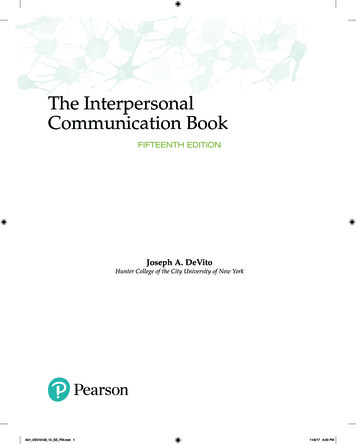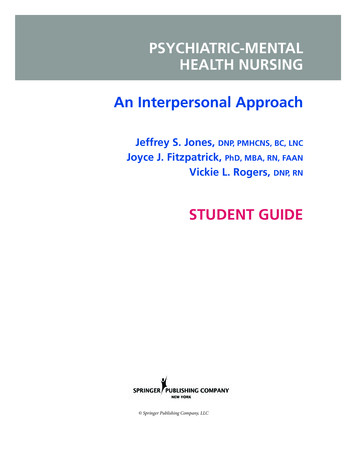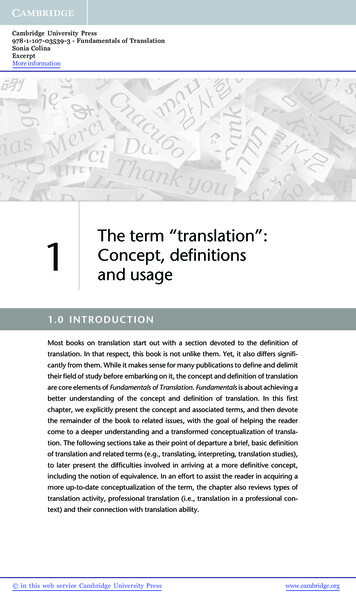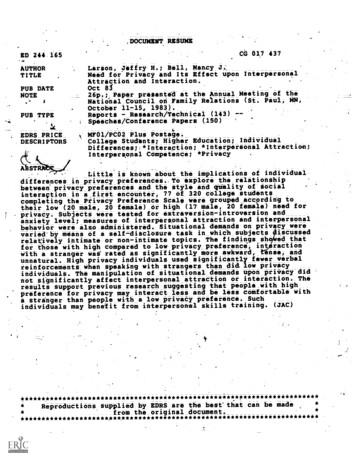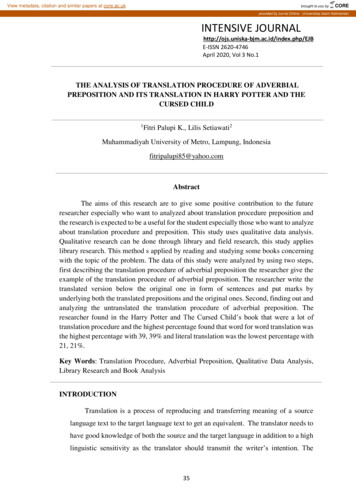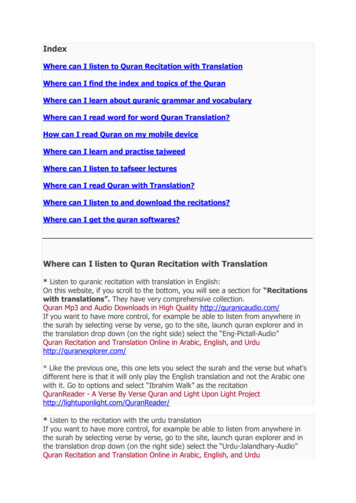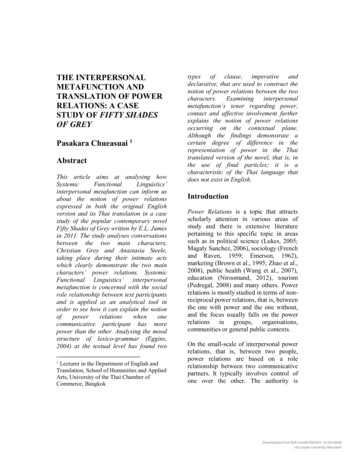
Transcription
THE INTERPERSONALMETAFUNCTION ANDTRANSLATION OF POWERRELATIONS: A CASESTUDY OF FIFTY SHADESOF GREYPasakara Chueasuai 1AbstractThis article aims at analysing howSystemicFunctionalLinguistics’interpersonal metafunction can inform usabout the notion of power relationsexpressed in both the original Englishversion and its Thai translation in a casestudy of the popular contemporary novelFifty Shades of Grey written by E.L. Jamesin 2011. The study analyses conversationsbetween the two main characters,Christian Grey and Anastasia Steele,taking place during their intimate actswhich clearly demonstrate the two maincharacters’ power relations. SystemicFunctional Linguistics’ interpersonalmetafunction is concerned with the socialrole relationship between text participantsand is applied as an analytical tool inorder to see how it can explain the notionofpowerrelationswhenonecommunicative participant has morepower than the other. Analysing the moodstructure of lexico-grammar (Eggins,2004) at the textual level has found two1Lecturer in the Department of English andTranslation, School of Humanities and AppliedArts, University of the Thai Chamber ofCommerce, Bangkoktypes of clause, imperative anddeclarative, that are used to construct thenotion of power relations between the twocharacters. Examining interpersonalmetafunction’s tenor regarding power,contact and affective involvement furtherexplains the notion of power relationsoccurring on the contextual plane.Although the findings demonstrate acertain degree of difference in therepresentation of power in the Thaitranslated version of the novel, that is, inthe use of final particles; it is acharacteristic of the Thai language thatdoes not exist in English.IntroductionPower Relations is a topic that attractsscholarly attention in various areas ofstudy and there is extensive literaturepertaining to this specific topic in areassuch as in political science (Lukes, 2005;Magaly Sanchez, 2006), sociology (Frenchand Raven, 1959; Emerson, 1962),marketing (Brown et al., 1995; Zhao et al.,2008), public health (Wang et al., 2007),education (Niroomand, 2012), tourism(Pedregal, 2008) and many others. Powerrelations is mostly studied in terms of nonreciprocal power relations, that is, betweenthe one with power and the one without,and the focus usually falls on the powerrelations in groups, organisations,communities or general public contexts.On the small-scale of interpersonal powerrelations, that is, between two people,power relations are based on a rolerelationship between two communicativepartners. It typically involves control ofone over the other. The authority isDownloaded from Brill.com04/09/2022 12:00:04AMvia Loyola University Maryland
MANUSYA: Journal of Humanities, Special Issue No.23, 2017conducted through the person with powermaking decisions with determinedoutcomes to the person without power(Galinksy et al., 2003).power relations are seen as bringing forththe manipulation of the ST that can beseen in the TT. In TS, power relationshave been scrutinised either betweentranslation agents (translator, editor orpublisher) and the ST. For example,Siponkoski (2013) has examined theinterpersonal cooperation and negotiationof the three translation agents: translators,copyeditors and a consultant on the editingprocess of the translation of Shakespearefrom English to Finnish; Chueasuai (2010)has explored the translation shifts in theThai translation of the American women’smagazine Cosmopolitan whose explicitsexual content has been toned down by theeditor-in-chief of the Thai version to suitthe local audience and society, wheresexual topics still relatively belong to theprivate sphere; Montenegro (2005) hasexamined power relations between the STauthors and readers, the ST and TT writersand the ST author and the translator of theEnglish-Portuguese health pamphlet tofind out the power each agent has and howthey negotiate and legitimise their ownideology in the text.According to French and Raven (1959), aspecific type of relationship between twoindividuals becomes the basis of powerand determines a particular base of powerbetween the two. They define fivecommon and important bases of power,each of which is dynamic; that is, the baseof power can constantly change from oneto another depending on the changingvariables in a given relationship. The fivebases of power are: a. reward power: theability of one person with power (P1) toreward the one without power (P2); b.coercive power: the ability of P1 to punishP2 if the latter fails to perform and/orachieve a given task; c. legitimate power:the way in which P2 feels that P1 has alegitimate right to influence him/her andP2 is obliged to accept this particularinfluence; d. referent power: the conceptof an identical entity; that is, P2 has afeeling of oneness with P1 and desires togain P1’s identity. P2 thus behaves,believes and perceives as P1 does; and e.expert power: a perception P2 has of P1 asan expert or knowledgeable person in aparticular area.A number of research studies in TS havealso investigated power relations betweenagents and authority (state or government)such as Garnemark (2012), Gómez Castro(2008), Keratsa (2005) and Merino &Rabadan (2002) who have looked at howthe Franco dictatorship in Spain affectedtranslations of books, theatrical andfictional works and films from foreignlanguages into Spanish. The studies showthat censorship by the authorities had aconsiderable impact on the re/productionof these works in order to conform to theuniformity of the nation during the regime.In the context of Translation Studies(hereafter TS), the notion of powerrelations has attracted a number oftranslation scholars’ attention. Thediscipline investigates how powerrelations affect transfer of meaning fromthe source text (ST) to the target text (TT)toachievecertaindeterminedcommunicative purposes. In other words,2Downloaded from Brill.com04/09/2022 12:00:04AMvia Loyola University Maryland
The Interpersonal Metafunction and Translation of Power Relations:A Case Study of Fifty Shades of GreyOther researchers include Calzada Pérez(2007) who has called for translators’contribution and empowerment to conflictsettlement, particularly in localisinginternational advertisements; and Baker(2007) who has looked at communitytranslators as a party who can manipulatetranslation either to support or resist acapitalist regime; to name but a few. Thesestudies are mostly concerned with powerrelations between translators, translationagents and relevant authorities by meansof the role each party plays in producing,negotiating, altering and legitimisingmedia and political texts conveying certainideologies to their audiences.specific metafunction is applied as theanalytical tool.The interpersonal metafunction, which theauthor will discuss in detail in the nextsection, is employed to explore theexpression and translation of powerrelations occurring at the level of theintimateinterpersonalrelationshipspresented both in the source and targettexts of the contemporary novel FiftyShades of Grey written by E. L. James in2011 and its Thai translation. The storyrevolves around an intimate relationshipbetween a newly graduated collegestudent, Anastasia Steele, and a handsomeyoung business tycoon, Christian Grey,who proposes a contract of sexual actsconsent to Steele since he wants to haveher as his new sexual partner. Theirrelationship is specifically and primarilymanifested through intimate acts that areinitiated by the sexually experienced malepartner on the sexually naïve femalecharacter. Their conversations taking placeduring these specific occasions thusclearly demonstrate their power relations,especially when erotic role play isinvolved.This paper, however, takes a differentapproach. It attempts to analyse how thenotion of power relations expressed in agenre of contemporary literature which hasbeen neglected by previous TS scholarscan be informed by applying SystemicFunctional Linguistics’ (henceforth SFL)interpersonalmetafunctionasananalytical tool. This is because in thecontext of SFL that regards language as apurposeful means of communication, theinterpersonal power relations demonstratesthe social role relationship between twocommunicative partners in specificcommunicative settings. Language used inthis particular relationship requires certainlexico-grammatical choices to manifest thespecific attitudes one communicativeparticipant has towards the other. FromSFL’s perspective, this can be realised ininterpersonal metafunction which is one ofthe three metafunctions of language forwhich the paper will give an overview inthe next sub-section. Therefore, thisThe intimate interpersonal relationship liesparticularly in the erotic practices of thesetwo characters that tend to belong toBDSM, which stands for three pairs of roleplay: Bondage and Discipline; Dominanceand Submission; and Sadism andMasochism (Barker, 2013). This variety oferotic acts involves the use of control, roleplay and restraint. The term also suggestsa pairing with mutual consent between thepartner with more power (Discipline,Dominance and Sadism) and the other3Downloaded from Brill.com04/09/2022 12:00:04AMvia Loyola University Maryland
MANUSYA: Journal of Humanities, Special Issue No.23, 2017with less, if no, power (Bondage,Submission and Masochism). Exertion ofpower seems to be obvious in particularbetween the Dominant (Dom), the partnerwho dominates or controls erotic acts, andthe Submissive (Sub), the partner who issubmissive or sstatethatlanguagesimultaneously performs three socialfunctions, or “metafunctions” whichconsist of ideational, interpersonal andtextual metafunctions. Firstly, languagerepresents the knowledge and experienceabout and of the world of the languageuser through text (both spoken andwritten) or the ideational function. Themeaning generated from this function iscalled ideational meaning. Secondly,language engages in expressing social rolerelationships between communicativepartners or the interpersonal function. Thisparticular function constructs interpersonalmeaning. Thirdly, language constructs andorganises the text according to therequirements and conventions and relatesthe text to the relevant social context, orthe textual function. This last functioncreates textual meaning. To examinepower relations that mark a type ofinterpersonalrelationship,theinterpersonal metafunction thus seems tobe the most relevant and will be applied inthis study.The type of relationship appearing in thenovel connotes a power relationshipbetween the male dominant (Dom), or P1,and the female submissive (Sub), or P2,particularly in erotic settings. Sinceintimate acts between the Dom and theSub that convey power relations betweenthe two characters both via verbal andnonverbal means are abundant anddescribed in great detail, the studytherefore examines the conversationstaking place during these acts. However,although other types of communicative actsuch as eye gazing, gesture, posture, etc.,can be used to manifest power, this studyintends to focus only on the first type ofcommunication: verbal language.In the next sub-sections, the paperprovides an overview of the SFL’s notionof interpersonal metafunction, beforeproceeding to how SFL has been appliedin TS.In order to explain the interpersonalmeaning simultaneously occurring on thetextual plane, it is necessary to explorefurther to the lexico-grammatical layer oftext where words and structures in text areconstructed. SFL refers to this specificconfiguration as mood2 which is definedas “the organization of a set of g of Mood (the essential part ofthe clause) and Residue (the part that canSystemic Functional Linguistics’interpersonal metafunctionTo study interpersonal relationships insociety including this specific type ofrelationship that communicates via verbalcommunication, a strand of linguistics,SFL offers detailed systematic analyticaltools to help explain the social rolerelationship between communicativeinteractants (Halliday and Matthiessen,2To differentiate between these two differentterms, Mood as clause component is in italics.4Downloaded from Brill.com04/09/2022 12:00:04AMvia Loyola University Maryland
The Interpersonal Metafunction and Translation of Power Relations:A Case Study of Fifty Shades of Greybe left out). The necessary component of aclause, or Mood, is referred to as the mainpoint of argument that is s. The Mood componentconsists of Subject (a nominal-typeelement) and Finite (a verbal-typeelement). The less important clausecomponent, or Residue, consists ofPredicator (content parts of the verbalelements), Complement (a nominalparticipant in the clause) and Adjuncts(adverbial and prepositional elementswhich add extra information to the clauseconsisting of Circumstantial Adjunctswhich add ideational content to the clause;Modal Adjuncts which add interpersonalmeanings to the clause; and TextualAdjuncts which deal with the organisationof the clause, respectively).about), tenor (the relationship of the textcommunicators) and mode (the type oflanguage used and role the languageplays).Whilst the framework allows theinterpersonalrelationshipstobescrutinised on the textual plane throughthe mood pattern of the interpersonalmeaning, italsoelaboratestherelationships in the tenor variable of thesituational context. Based on previousstudies of language variation and rolerelationship variables, Eggins (2004: 99101)appliesPoynton’s(1985)classification of tenor, which states thatthe specific choice of language acommunicativepartneralterssimultaneously relies on three relateddimensions: power, contact and affectiveinvolvement, defined and exemplified asfollows.This particular lexico-grammatical patternof mood suggests how the text producerestablishes his or her relationship with thetext receiver through four basic “speechfunctions”, namely, statements, questions,offers and commands. These four types ofspeech functions are presented in threestructural mood types: the declarativeclause (to make a statement), theinterrogative clause (to question or offer)and the imperative clause (to command).A. Power refers to the rolebetweencommunicativeparticipants, whether theyhave equal (reciprocal) orunequal(non-reciprocal)power. Friendship is anexample of an equal power,whereas boss and employeeexemplifies an unequal powerrelationship.B. Contact indicates frequency ofcontact between the speechinteractants, whether theyhave frequent or infrequentcontact. Spouses tend to haveconstant and frequent contactin contrast to the occasionalandinfrequentcontactbetween acquaintances.From theSFLperspective,themetafunctions of language operate withinthe realm of two contexts: the immediatecontext of situation and the larger contextof culture. The first context occurring nextto text is the context of situation. Itoperates through the construct of register,consisting of three register variables: field(the topic of the text or what the text is5Downloaded from Brill.com04/09/2022 12:00:04AMvia Loyola University Maryland
MANUSYA: Journal of Humanities, Special Issue No.23, 2017C. Affective involvement pointsto levels of emotionalcommitment, whether it ishigh or low. Lovers or friendstend to have high affectiveinvolvementwhilelowaffective involvement can bewitnessed in work colleagues.analyse power relationships, SFL allowsscrutiny from the expression plane ofmood structure of the lexico-grammar thatrealises the interpersonal metafunction onthe textual plane, which is determined bytenor of register variables that are againshaped by the genre of the cultural contexton the content plane.This sub-section has attempted to give anoverview of SFL that is applied to explainthe notion of power relations. In the nextsub-section, the article discusses SFLbriefly in the context of TS.Apart from these three dimensions thatplay a significant parts in how one choosesto use language, the formal or informalsituation also determines the languagechoice (Eggins, 2004). In an informalsetting, participants tend to be of equalpower, with frequent contact and highaffective involvement. On the other hand,in a formal situation, participants seem tohave unequal power, infrequent contactand low affective involvement. These twodifferent situations affect lexical choices;that is, in informal situations, the languagetends to be more attitudinal, colloquial,abbreviated or even vulgar. In formalsettings, however, the language appearsmore objective, written, complete andpolite.Systemic Functional Linguistics andTranslation StudiesSFL has been applied in TS by a greatnumber of researchers (House, 1981;Mason and Hatim, 1990; Bell, 1991;Baker, 1992; Munday, 2001; to name onlya few). One reason is that this specificbranch of linguistics provides a detailedanalytical tool to work on both fictionaland non-fictional data. SFL has been wellused in analysing not only the languagepeople really use in different settings butalso the language found in novels,literature and poems (See, for example,Huang, 2002; Li, 2007, to name only afew.). SFL’s three metafunctions –ideational, interpersonal and textual –allow systematic study through theirfunctional lexico-grammatical componentsto explain how the chosen text iscomposed (textual), what it is about(ideational) and who the text is producedby and for whom (interpersonal).Furthermore, SFL allows researchers toinclude contexts in their descriptive textualanalyses since systemists see contexts asBoth text and context of situation aresituated within the gigantic sphere of thecontext of culture that operates through theconceptualisation of genre. In the SFLsense, genre is defined as a purposeorientated social process that is sociallyconventionalised and sequentially operated(Halliday, 1978). It is considered the mostabstract level of context in whichmeanings are ideologically constructed.From the brief definitions given to theconstituents of text and context and theirinterrelationships above, to specifically6Downloaded from Brill.com04/09/2022 12:00:04AMvia Loyola University Maryland
The Interpersonal Metafunction and Translation of Power Relations:A Case Study of Fifty Shades of Greythe essential meaning-making elements.Although the three metafunctions –ideational, interpersonal and textual – arenormally applied in analyses, such as inthe work of the aforementioned TSscholars, there are studies that apply aparticular metafunction as the analyticaltool, such as the configuration oftransitivity of ideational metafunction inHuang (2002) comparing process types in,for example, the translation of a Chinesepoem and its six English translations; andChueasuai (2013) examining translationshift between the American magazineCosmopolitan and its Thai version. Themoodstructureofinterpersonalmetafunction has been adopted in, forexample, Huang (2004) in defining therelationship between the characters of aChinese poem and its English versions; Li(2007) in studying equivalence inmeanings in Chinese poetry and itsEnglish translations; Munday (2009) inanalysing the construction of the writerreader relationship in Spanish politicaltexts and their English translations; andXia (2016) in comparing the differences inthe mood system between the Chinese andEnglish languages and potential translationstrategies. The thematic structure oftextual metafunction has been employedin, for instance, Munday (1998, 2000,2008) in analysing literary texts betweenSpanish and English; Ventola (1995) incomparing German academic textstranslated into English; and Liu and Yang(2013) in investigating various Chinesetranslations of a Francis Bacon text intoEnglish.social role relationship between textparticipants appearing in the ST and theTT, the mood structure of the interpersonalmetafunction has tended to be a usefulanalytical tool. This article thus attemptsto apply this specific configuration toanalyse how it can inform us about thepower relations between the textparticipants of the analytical data.In the next section, the paper demonstratesa brief description of how the analyticaldata is investigated.MethodAn analysis based on SFL’s interpersonalmetafunction was carried out with datacollected from conversations that takeplace during intimate contacts betweenAnastasia Steele and Christian Grey whoare the two main characters in the popularcontemporary novel Fifty Shades of Grey.Conversations taking place outside of thisspecific context, such as over thetelephone, during meals, etc., are excludedfrom the study since the focus lies only onthe notion of power relations that tend tobe expressed clearly during their eroticencounters, specifically their BDSM roleplay.This study attempts to apply SFL’sinterpersonal metafunction as an analyticaltool in order to examine how this specificlinguistic concept can inform us about thenotion of power relations. As brieflymentioned in the previous section, sinceSFL tends to lend itself to being applied asan analytical tool to explain linguisticphenomena occurring in communicativeFrom these few examples of the previousstudies that apply SFL in TS, to identify7Downloaded from Brill.com04/09/2022 12:00:04AMvia Loyola University Maryland
MANUSYA: Journal of Humanities, Special Issue No.23, 2017settings through its detailed textual andcontextual components, it has been thusapplied in the current study. Following theSFL conceptualisation of mood pattern inthe lexico-grammar, the social rolerelationships between text participants canbe expressed through four basic speechfunctions: statement, question, offer andcommand. The first speech function,statement, is presented in the declarativeclause while the second and third speechfunctions, question and offer, arepresented in the interrogative clause; thelast speech function – command – ispresented in the imperative clause,respectively. Table 1 below illustrates thefour types of speech function and therelevant mood structures of the clause andexamples.The speech functions and clauses aboveshow that the command function andimperative clause relate closely to thenotionofpowerrelationsincommunicative settings. A communicativepartner can show his or her power over theother through commanding something thatcan be expressed in an imperative clause.However, Eggins (2004) proposes that notonly can commands or demands for goodsand services be manifested in imperativesbut they also can be in the forms ofdeclaratives and modulated interrogatives.The study, therefore, analyses these threemood structures (declarative, imperativeand modulated interrogative) as thelinguistic resources for displaying powerrelationships between the two maincharacters of the novel during theirintimate acts and how this is transferred tothe TT. After identifying and categorisingthe analytical data in the ST according toits linguistic structure, its Thai translationis analysed based on the same structuresand compared with how the powerrelations are translated in the TT. Theauthor also provides the Englishtranscriptions of Thai sentences accordingto the Royal Institute of Thailand4 as wellas a word-by-word translation. For ease ofthe analysis, however, back translation(BT) from Thai into English has beencarried out. Then both ST and its BT areplotted in a tabula form according to themood lexico-grammatical structure ofSFL’s interpersonal metafunction forcomparison.Table 1 Speech functions and relevantmood structures (Eggins, veEXAMPLE3“I’d like to do thatagain.” (p. 139)QuestionInterrogative“ but will youstop biting it?”(p. 156)OfferInterrogative“Why don’t youjoin me?”(p. 157)CommandImperative“Show me how youpleasure yourself.”(p. /03/416 2157.pdf lastaccessed on 17th November 2017.3The examples are taken from the Englishversion.8Downloaded from Brill.com04/09/2022 12:00:04AMvia Loyola University Maryland
The Interpersonal Metafunction and Translation of Power Relations:A Case Study of Fifty Shades of Greyclauses, respectively. It was found that 25(83.3%) imperative and 5 (16.7%)declarative clauses in the ST were nottranslated in the TT.Findings and DiscussionAs was briefly described in the previoussection, Eggins (2004) posits that thespeech function of command can beexpressed in three types of mood clause:imperative, declarative and modulatedinterrogative clauses. However, the currentstudy found only imperative anddeclarativeclausesconveyingcommanding messages reflecting thepower relationship between the Dom andSub. No modulated interrogative clausewas found to be used to manifest power.This section thus exemplifies theimperative and declarative clauses fromthe collected data by dividing the analysisinto two levels: textual and contextual.This division is ultimately for ease of theexplanation only since, in reality, text andcontext are inseparable.Table 2 Types of clause and percentage ofanalysed data in the Englishand Thai versionsEnglish VersionThai esAmong the 151 clauses of imperativestructure in the ST, 140 clauses (92.7%)are produced by Grey, with 11 clauses(7.3%) by Steele; 71 declarative clauses(93%) belong to Grey and 5 clauses (7%)to Steele. In the TT, of all 126 imperativeclauses, 117 clauses are spoken by Greyand 9 by Steele and 66 and 5 declarativeclauses belong to Grey and Steele,respectively.Textual AnalysisTable 2 below demonstrates the totalnumber of 227 clauses found in theEnglish version and 197 clauses in theThai version. The difference in number isdue to deletions in the target text whichwas the result of the Thai editor’s decisionas stated in the preface of the Thaiversion. 5 Of all the clauses found in theST, 151 (66.5%) and 76 (33.5%) areimperative and declarative clauses,respectively. In the TT, 126 (64%) and 71(36%) are imperative and declarativeIn what follows, in order to analyse howthe mood structure of the interpersonalmetafunction can inform us about thenotion of power relations, the papershowcases and discusses, firstly, theimperative clauses with selected examplesbefore proceeding to the declarativeclauses with examples.5The Thai editor states that “.[b]ut in thelinguistic process, it is necessary that the draftof some chapters (of the translation) needs tobe polished, edited and shortened whereappropriate.” (vi, my translation).9Downloaded from Brill.com04/09/2022 12:00:04AMvia Loyola University Maryland
MANUSYA: Journal of Humanities, Special Issue No.23, 2017Imperative ClauseExample 1Power relationships between P1 and P2appear to be best expressed in theimperative clause. This is in particularwhen P1 wants P2 to do something. Thestudy found the mood structure analysisprovides detailed explanations of thepower relations as shown in the ��เองยังไง” aeng hai phom du siwa khun hai khwam-suk tuaeng yang-ngaishow tomeseeFN*yougive pleasureyourself how[“Show me you giveyourself pleasure mentTextualResidueShowTTGrey: “Show me how youpleasure yourself.” (p.114)Grey: “แ ส ด ง ให้ ผ ม ดู สิ ว่ า คุ ณ ใ unctMoodComplementTextual AdjunctResidue*(FN final particle)This example is taken from the first intimateencounter between Grey and Steele thattakes place at his apartment. Grey plays theDom role of is the one with power, or P1,while Steele takes the Sub role of is the onewithout power, or P2. As the dominant, P1orders P2 to do what he wants that pleaseshim. In the setting, P1 orders P2, who issexually inexperienced, to perform selfgratification before him. The interpersonalfunction of language that demonstratesrequests can be realised in the imperativeclause, which is a typical means ofconveyingdemandsorcommands.Generally, the mood structure of animperative clause omits Mood (and theSubject) but starts with Residue. Thisparticular mood structure, i.e. without theSubject ‘You’, gives a direct command tothe communicative partner who realises withwhom the command is being used. The onewho uses the imperative clause thusrepresents P1 who projects his greater powerto P2. Example 1 shows near similar moodstructure between the two versions, both ofwhich express demand. This can be seen10Downloaded from Brill.com04/09/2022 12:00:04AMvia Loyola University Maryland
The Interpersonal Metafunction and Translation of Power Relations:A Case Study of Fifty Shades of Greyrelations between P1 and P2. 6 Thus thetranslation tends to show slightly strongercommand and power than the originalversion.from the first Residue consisting ofPredicator (Show) and Complement (me)that requests P2 to act as directed. However,in the Thai translation there is a final particleafter the Complement (me). The secondResidue also shows a similar structure:Predicator (pleasure) and Complement(yourself) in the original and Predicator(give) and Complement (yourself pleasure)in the translation that shares similarmeaning. However, the Textual Adjunct‘how’ in the TT appears at the end of theclause since, in the Thai language, thequestion words appear at the end of theclause. Also, it should be noted that, in theThai version, there is a final particle ‘สิ ’ afterthe Complement (me). In the Thai language,a final particle, or phrase/clause/sentenceending word, occurs at the end of phrases,clauses and sentences. It prevents phrases,clauses and sentences from ending abruptly.Also, it adds an extra meaning to the wholemeaning of the phrase, clause and sentence(Deepadung and Ratanakul, 1997). Thisspecific final particle can be used at the endof imperative clauses and sentences
Shades of Grey written by E. L. James in 2011 and its Thai translation. The story revolves around an intimate relationship between a newly graduated college student, Anastasia Steele, and a handsome young business tycoon, Christian Grey, who proposes a contrac
